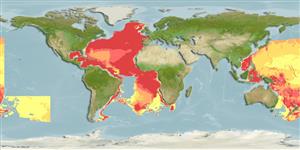Classification / Names
Common names from other countries
Main reference
Size / Weight / Age
Max length : 15.9 cm (female)
Environment
Marine; bathypelagic; depth range 360 - 1000 m (Ref. 86949)
Climate / Range
Deep-water, preferred ?
Distribution
Short description
Dorsal
soft rays
(total): 5-7;
Anal
soft rays: 4 - 5. Distinguishing characteristics: esca with tapering, internally pigmented, anterior appendage, becoming proportionally longer with growth, and usually bearing 2 short, unpigmented filaments on anterior margin near distal tip; unpaired, unpigmented filamentous medial escal appendage normally consisting of numerous branched filaments, flanked on each side by a similar filamentous medial appendage; terminal escal papilla truncated, sometimes with distal spot of dark pigment; posterior escal appendage is laterally compressed and crescent-shaped, sometimes pigmented on distal margin; unpigmented filamentous lateral escal appendage on each side; absence of anterolateral escal appendages; epibrachial I bearing 1-5 teeth; pharyngobranchial II toothed; upper jaw with 29-180 teeth, lower jaw with 53-160 teeth; vomer with 4-10 teeth (Ref. 86949).
IUCN Red List Status (Ref. 115185)
Threat to humans
Harmless
Human uses
More information
Common namesSynonymsMetabolismPredatorsEcotoxicologyReproductionMaturitySpawningFecundityEggsEgg development
Age/SizeGrowthLength-weightLength-lengthLength-frequenciesMorphometricsMorphologyLarvaeLarval dynamicsRecruitmentAbundance
ReferencesAquacultureAquaculture profileStrainsGeneticsAllele frequenciesHeritabilityDiseasesProcessingMass conversion
Tools
Special reports
Download XML
Internet sources
Estimates of some properties based on models
Phylogenetic diversity index
PD50 = 0.5000 many relatives (e.g. carps) 0.5 - 2.0 few relatives (e.g. lungfishes)
Trophic Level
3.9 ±0.7 se; Based on size and trophs of closest relatives
Resilience
High, minimum population doubling time less than 15 months (Preliminary K or Fecundity.)
Vulnerability
Low to moderate vulnerability (29 of 100)
Price category
